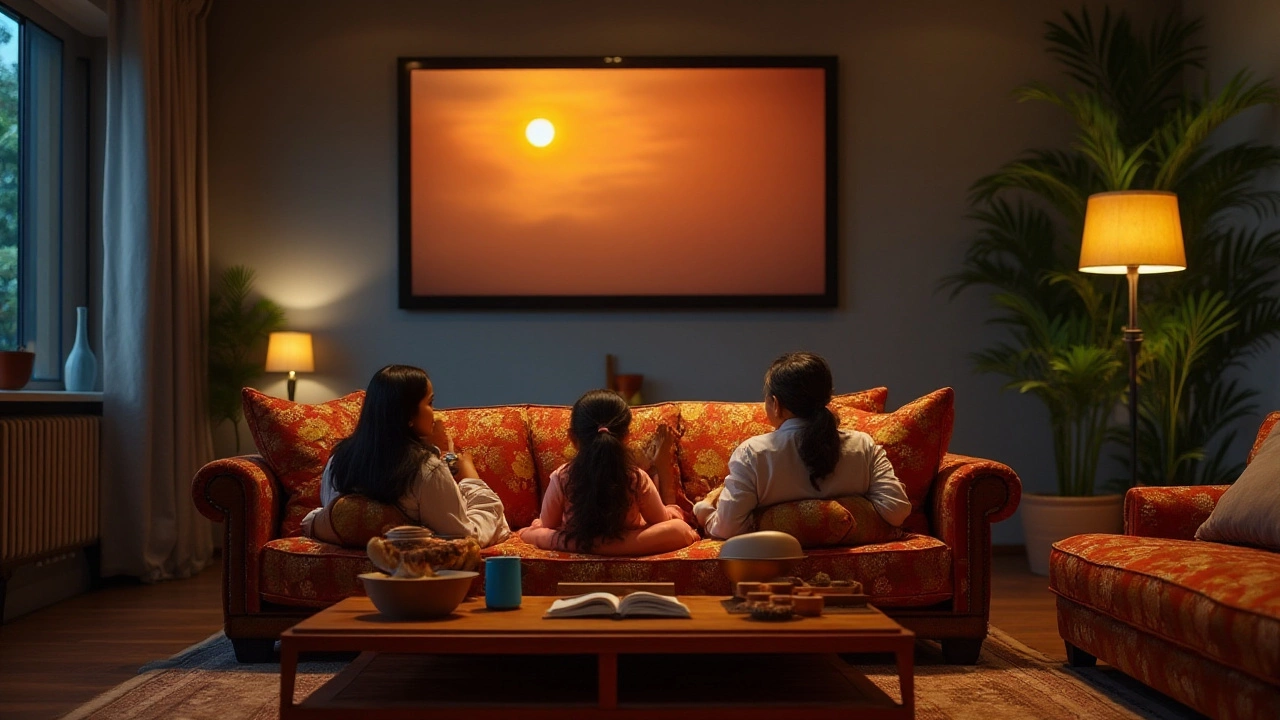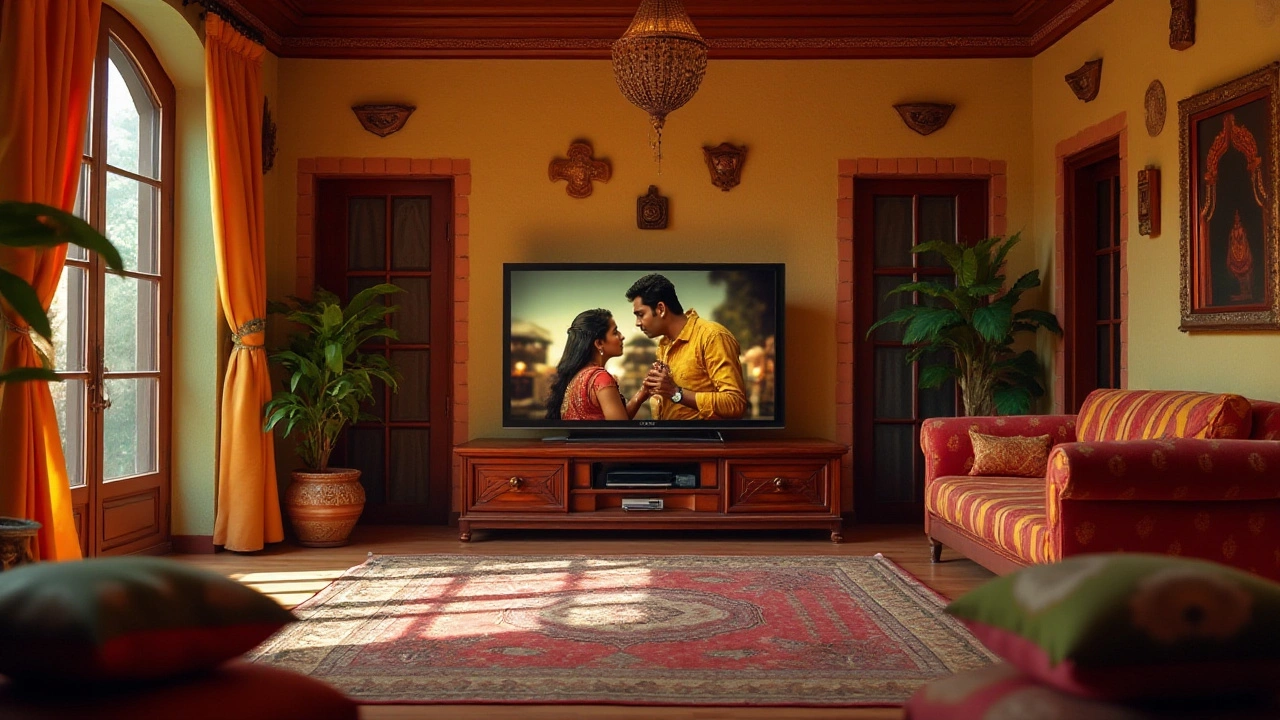The pursuit of the perfect TV setup often leads us to ponder: should it be positioned high or low? It's not a one-size-fits-all question, as everyone has different living spaces and preferences. Finding the sweet spot for placing your TV can transform an average night into an immersive movie marathon.
Let's delve into some guidance to ensure your TV offers peak performance both in clarity and comfort. The decision hinges on more than just personal taste; it requires understanding your room's dynamics, from viewing angles to seating arrangements, helping you craft an entertainment nook that's visually and functionally ideal.
- Understanding Viewing Angles
- Determining the Right Height
- Choosing the Right Stand
- Designing for Comfort and Style
Understanding Viewing Angles
When it comes to achieving the ultimate viewing experience, viewing angles play a pivotal role. The angle at which you view your TV can dramatically influence the quality of the picture you perceive. If you've ever noticed colors looking dull or images appearing distorted when viewed off-center, you're witnessing the effect of poor viewing angles. Ideally, you want your TV placed so the middle of the screen is at eye level while you're seated, which typically translates into the screen's center being 42 inches from the floor for most households. This positioning will help minimize neck strain and encourage hours of comfortable viewing without the aches.
In today's world of high-definition televisions, the technology behind displays is also a factor. For instance, LCD screens can suffer from color and contrast shifts when viewed at extreme angles. The solution for these screens is often to be positioned more directly. In contrast, OLED screens are known for offering relatively consistent image quality even when viewed at wider angles. Yet, despite this superior feature, you shouldn't place an OLED too high or low as it can still affect visual comfort negatively. To effectively align both comfort and picture quality, start by arranging seating directly opposite your TV to limit the need for frequent shifts in viewing angles.
Did you know that human eyes are naturally positioned to look directly forward, typically at a 15-degree angle to the horizon line? This biological fact dictates why the optimal height for TV viewing places the screen's center just below horizontal sight lines, ensuring minimized strain. Some experts note that the angle should not exceed 30 degrees from the eye level for optimal viewing. This consideration becomes essential in multipurpose rooms where seating and TV arrangements frequently change. To adjust for this, many households opt for tilting mounts, which provide flexibility to achieve the correct angle by adjusting the TV vertically.
"The absence of an ideal viewing angle can lead to sore eyes and cramps," says Dr. Felicity Howard, an expert in visual ergonomics. "Proper placement enhances both the viewing experience and physical comfort."Whether you're enjoying the latest blockbuster or the penultimate episode of your favorite series, ideal angles ensure no details are missed. Specialists also recommend incorporating elements such as non-glare lighting to further alleviate potential distractions. By focusing on angles and visual ergonomics, your viewing environment can transform into a theater-like setting, combining aesthetics with function seamlessly.

Determining the Right Height
Choosing the right height for your TV is paramount to achieving the best viewing angle and comfort. The ideal height is not set in stone, but one useful rule of thumb is to position the center of the screen at eye level when you're seated. This often translates to about 42 inches from the floor to the center point of the TV, although this can vary based on individual preferences and the height of your seating. The ergonomic consideration here is simple: reducing the strain on your neck and shoulders as you watch your favorite shows.
Imagine sinking into your sofa after a long day at work, eyes eagerly waiting to dance across the screen as soon as the play button is pressed. If your TV is placed too high or too low, it can quickly turn that anticipated relaxation into a discomfort battle. Personalize the height to suit your specific seating setup, room layout, and the state of modern TVs, many of which are much larger than older models and offer a more cinematic feel at different heights. It's crucial to consider aspects like glare from lights and windows, which might affect screen visibility depending on how high or low the TV is positioned.
When determining height, screen size plays a pivotal role. A larger TV might need to be slightly lower to ensure that the viewer can take in the entire picture without needing to move their head significantly. Since our eyes tend to focus on the center of the screen, having it too far above or below eye level can lead to discomfort over extended viewing periods. If you frequently switch between watching movies and playing video games, consider adjustments that might be needed for different types of content consumption. As technology progresses, people are moving towards wall mounting, which offers flexibility but also requires precision in height calculation.
Another aspect to consider is the unique elements of your living area. Vintage buildings with shorter ceilings might naturally limit how high you can go, while sprawling open-plan spaces might tempt you to place the TV higher than usual. Balance aesthetics with practicality; a well-placed TV can enhance your home decor. Some opt for adjustable TV mounts, which cater to various viewing needs. It's a modern solution that adjusts to your lifestyle changes, whether you're sitting on the couch with family or hosting a party where everyone watches standing up.
"The ideal TV height feeds into a room's feng shui," says interior designer Laura Day. "It's about making sure everything flows and feels natural, a harmony that brings peace to an entertainment space."Experimentation might be necessary. Before drilling holes or settling on a spot, test various heights by using cardboard cutouts or painter’s tape on the wall. This can give a tangible sense of where the effect is most visually pleasing. Don’t rush the decision; spend some days exploring the positioning before committing. Discuss seating dynamics with family or roommates, as everyone might have different comfort level preferences.
If you're still uncertain, it could be helpful to explore professional advice. Some experts provide consultation services tailored to your specific needs, taking into account the distances, angles, and other architectural factors. These insights can steer away from common pitfalls while maximizing the entertainment experience, turning your living room into a personal cinema.

Choosing the Right Stand
When setting out to pick the most fitting stand for your TV, it's crucial to evaluate the balance between aesthetics and function. A TV stand not only supports your television but also contributes to the room's style and atmosphere. Begin by considering the TV's width. It's advisable to choose a stand that is at least a few inches wider than the TV itself. This not only provides stability but also offers space for any additional equipment you might have, such as a soundbar or gaming console.
If your living room layout is on the quirky side, where corners play a significant role, corner stands can be a lifesaver. They allow you to utilize the room's geometry, opening up floor space and maintaining a clean line of sight across the room. Home decor magazines frequently spotlight such designs, showcasing how they harmonize with both classical and contemporary motifs.
Those chasing minimalism might find floating stands appealing. These fixtures elevate the TV off the floor and provide a sleek look while creating extra storage underneath. They mimic the effect of wall-mounted TVs without the need for drilling into your walls. A floating stand can be a statement piece in itself, adorning the space while meeting the practical need of adjusting to your perfect viewing angle.
"A well-chosen TV stand not only supports technology but becomes an integral part of the living space, embodying the essence of form meeting function." — Design Monthly Magazine
Take into account the material of the stand, which plays an instrumental role in both its longevity and style. Wood brings warmth, fitting well in rustic or traditional settings, whereas glass or metal lends a modern, industrial vibe. The choice of material impacts the stand's ability to anchor the room's aesthetic and support your TV securely.
Additional Features
For those with an eye on the future, consider stands with integrated cable management systems. These beautifully concealed conduits keep cables from becoming a tangled eye-sore. Units with adjustable shelves or height settings offer flexibility for evolving home entertainment setups. Some brands even incorporate wireless charging pads or USB ports for convenient tech integration, adding another layer to your TV setup's practical charm.

Designing for Comfort and Style
When it comes to designing your living space, achieving a blend of comfort and style is essential. Television setups are no different—they must balance aesthetics and ease of use. A significant aspect of this is the right TV height, which not only enhances viewing experiences but complements the room's decor. Many people consider their TV to be the focal point of a room, so ensuring it matches the rest of your interior design is crucial. For those keen on modern aesthetics, wall-mounted options are popular. They save floor space and give a clean, sleek finish, making them ideal for contemporary settings. However, careful planning about the height ensures that long viewing sessions don't result in neck strain. It’s all about aligning the center of the screen with your eye level when seated comfortably on your couch or chair.
Moreover, it’s vital to reflect on the type of TV stand you choose if wall mounts aren’t your preference. Traditional furniture setups can offer both storage and style in one package. Choose a stand that supports the weight of your TV and offers a pleasant contrast or harmony with your room's color scheme. Site the stand so that the TV keeps the central viewing angle horizontal, ensuring that the picture quality doesn’t degrade from unusual angles. A crucial tip for choosing the optimal stand is evaluating its height against the seating arrangement; you'll want your eyes to align naturally with the screen's center to maintain comfort without sacrificing your aesthetic vision. As Jane Thompson, a seasoned interior designer, rightly puts it,
So many underestimate the impact of alignment—it's a game-changer in both function and design.
Let's dive a bit deeper with regards to functionality: furniture isn't just about looks. Nowadays, TV stands with built-in cables and ports for easy connection to streaming devices or gaming consoles are in demand. Spacetop palms off the chaos caused by numerous cables tangled up beneath the screen. Improving organization behind the scenes amplifies both the style and ease of use you experience daily. When functionality is at its peak, the entire family benefits. Not having to struggle with tangled cords improves not only the space's cleanliness but also your enjoyment of using the space. Optimize without overcrowding—balance is the primary factor here. Experts advise a minimalistic assortment of two or three extra gadgets displayed prominently instead of a cluttered array of every item or device you own.
Moreover, personalization is a critical aspect. What suits one family may not suit another. Your choice of TV furniture, height, and style should reflect your lifestyle and viewing preferences. Do you host movie nights often or is background noise while you cook more your speed? Understanding your habits allows you to tailor the TV stand choice to perfectly suit your needs. However, aesthetics shouldn’t overpower practicality. It’s always worth taking the time to consult professionals or do thorough research—make sure each element you place in the room serves the dual purposes of beautifying the environment while facilitating your relaxation, whether it’s a bold stand or a subtle shelf backing your media equipment. But above all, ensure it mirrors the style and personality you wish to exude, allowing the setup to enhance the pleasures it’s intended to deliver.

